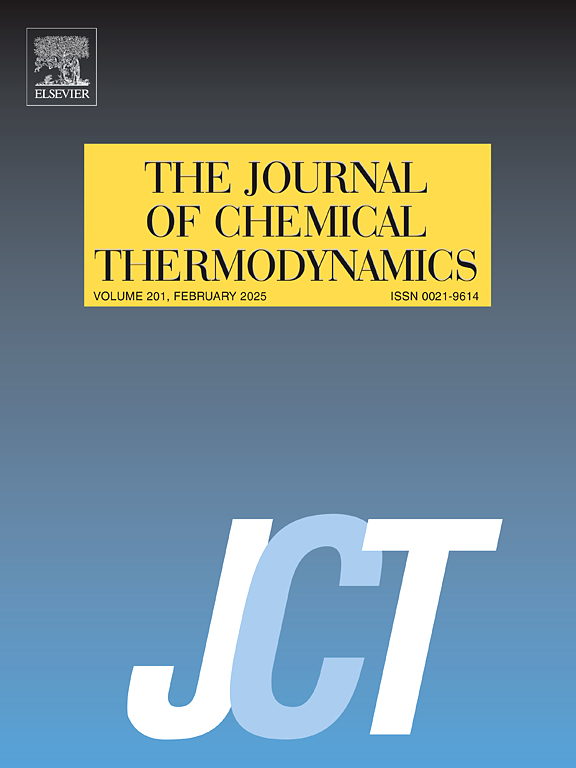Accurate density measurements of CO2 at the vicinity of the critical point by a single-sinker densimeter
IF 2.2
3区 工程技术
Q3 CHEMISTRY, PHYSICAL
引用次数: 0
Abstract
This study presents a renovated single-sinker magnetic suspension densimeter system for density measurements at temperature from 298.15 to 423.15 K and pressure up to 35 MPa. The expanded uncertainties (k = 2) are 25 mK for temperature, 4 kPa for pressure, and 0.05 % for density. The system was first used to measure density of nitrogen at temperature from 308.15 to 423.15 K and pressure up to 20 MPa, yielding an average absolute relative deviation of 0.05 % compared to the reference multi-parameter equation of state (EoS) of Span and Wagner. Density of carbon dioxide was then measured mainly at the vicinity of the critical point, where the reference EoS deviates from data in literature. Vapor pressure and liquid density at saturated conditions were also determined. The new experimental data were compared to data from literature, the reference EoS of Span and Wagner and the crossover EoS with strict asymptotic singular behavior and critical exponent at critical point by Yang et al. The results shows that the new data generally yield good agreement with most of literature data, while both EoS underestimate density at the vicinity of the critical point. The EoS of Yang et al., as compared to EoS of Span and Wagner, provides a more accurate description of critical-point behavior while yielding similar accuracy in density and pressure calculation.
用单沉式密度计在临界点附近精确测量CO2密度
本研究提出了一种改进的单下沉式磁悬浮密度计系统,该系统可在温度为298.15 ~ 423.15 K、压力为35 MPa的条件下进行密度测量。扩展不确定度(k = 2)温度为25 mK,压力为4 kPa,密度为0.05%。该系统首先用于测量温度为308.15 ~ 423.15 K,压力为20 MPa的氮气密度,与Span和Wagner的参考多参数状态方程(EoS)相比,平均绝对相对偏差为0.05%。然后主要在临界点附近测量二氧化碳的密度,参考EoS偏离文献中的数据。测定了饱和条件下的蒸汽压和液体密度。将新实验数据与文献数据、Span和Wagner的参考EoS以及Yang等具有严格渐近奇异行为和临界点临界指数的交叉EoS进行了比较。结果表明,新数据总体上与大多数文献数据吻合较好,而两种模型都低估了临界点附近的密度。与Span和Wagner的EoS相比,Yang等人的EoS提供了更准确的临界点行为描述,同时在密度和压力计算方面具有相似的精度。
本文章由计算机程序翻译,如有差异,请以英文原文为准。
求助全文
约1分钟内获得全文
求助全文
来源期刊

Journal of Chemical Thermodynamics
工程技术-热力学
CiteScore
5.60
自引率
15.40%
发文量
199
审稿时长
79 days
期刊介绍:
The Journal of Chemical Thermodynamics exists primarily for dissemination of significant new knowledge in experimental equilibrium thermodynamics and transport properties of chemical systems. The defining attributes of The Journal are the quality and relevance of the papers published.
The Journal publishes work relating to gases, liquids, solids, polymers, mixtures, solutions and interfaces. Studies on systems with variability, such as biological or bio-based materials, gas hydrates, among others, will also be considered provided these are well characterized and reproducible where possible. Experimental methods should be described in sufficient detail to allow critical assessment of the accuracy claimed.
Authors are encouraged to provide physical or chemical interpretations of the results. Articles can contain modelling sections providing representations of data or molecular insights into the properties or transformations studied. Theoretical papers on chemical thermodynamics using molecular theory or modelling are also considered.
The Journal welcomes review articles in the field of chemical thermodynamics but prospective authors should first consult one of the Editors concerning the suitability of the proposed review.
Contributions of a routine nature or reporting on uncharacterised materials are not accepted.
 求助内容:
求助内容: 应助结果提醒方式:
应助结果提醒方式:


